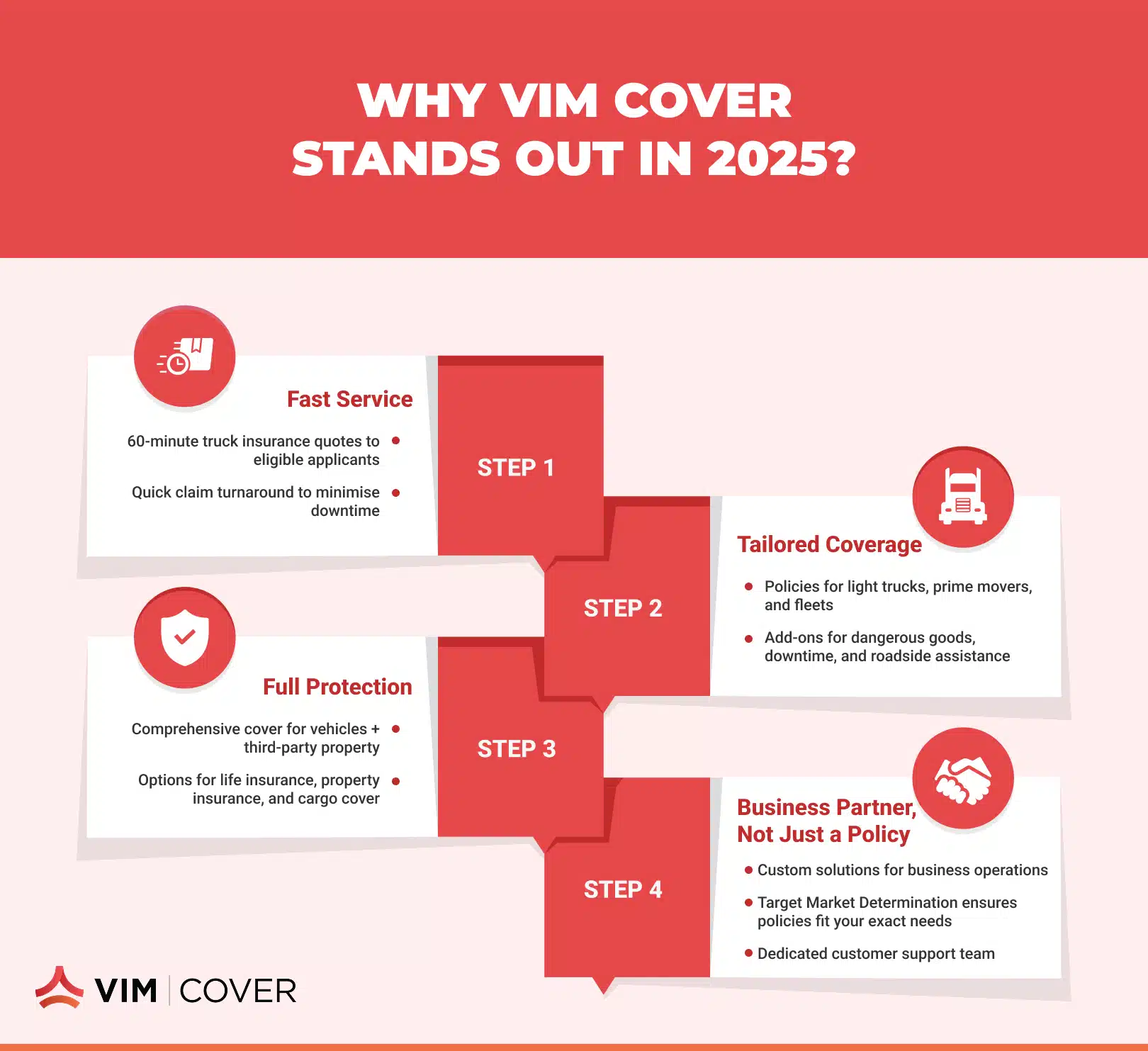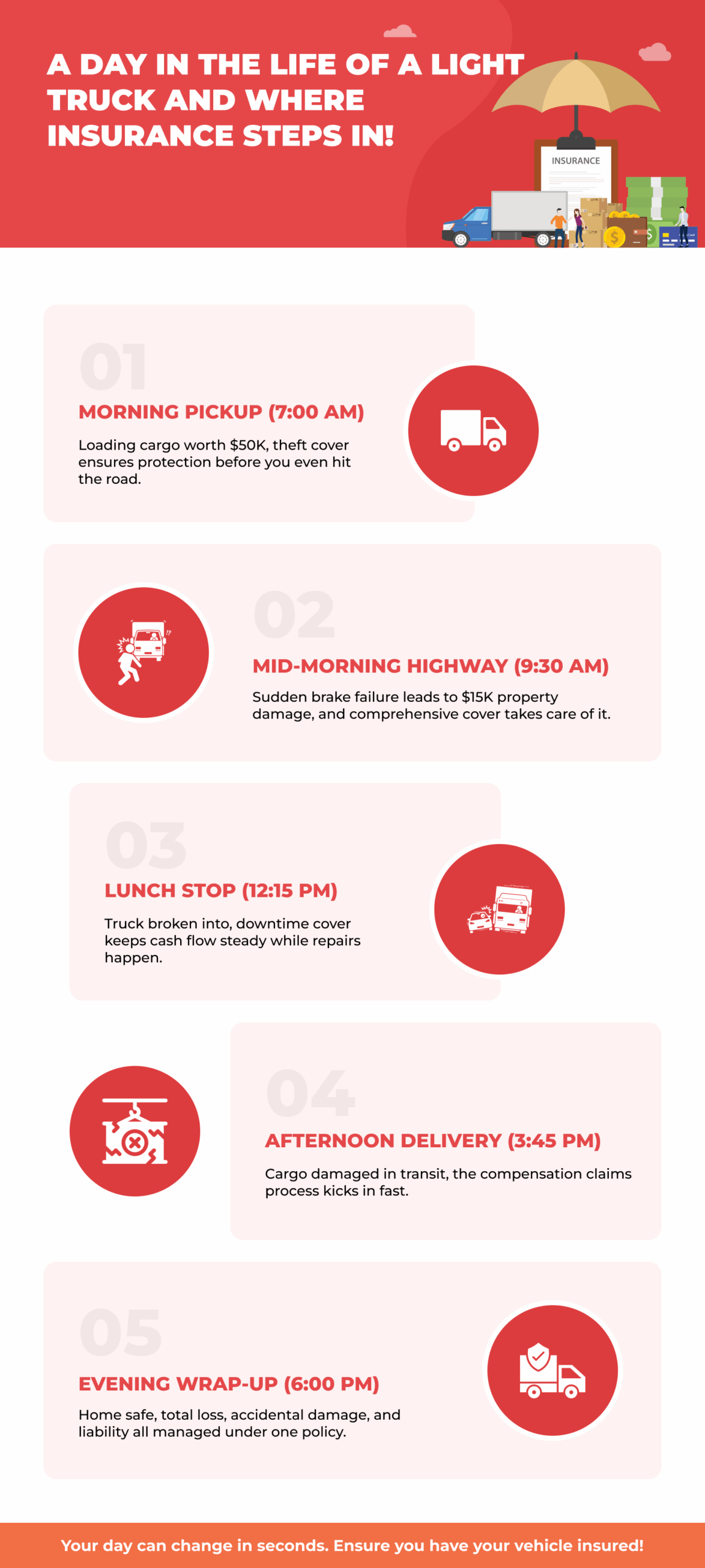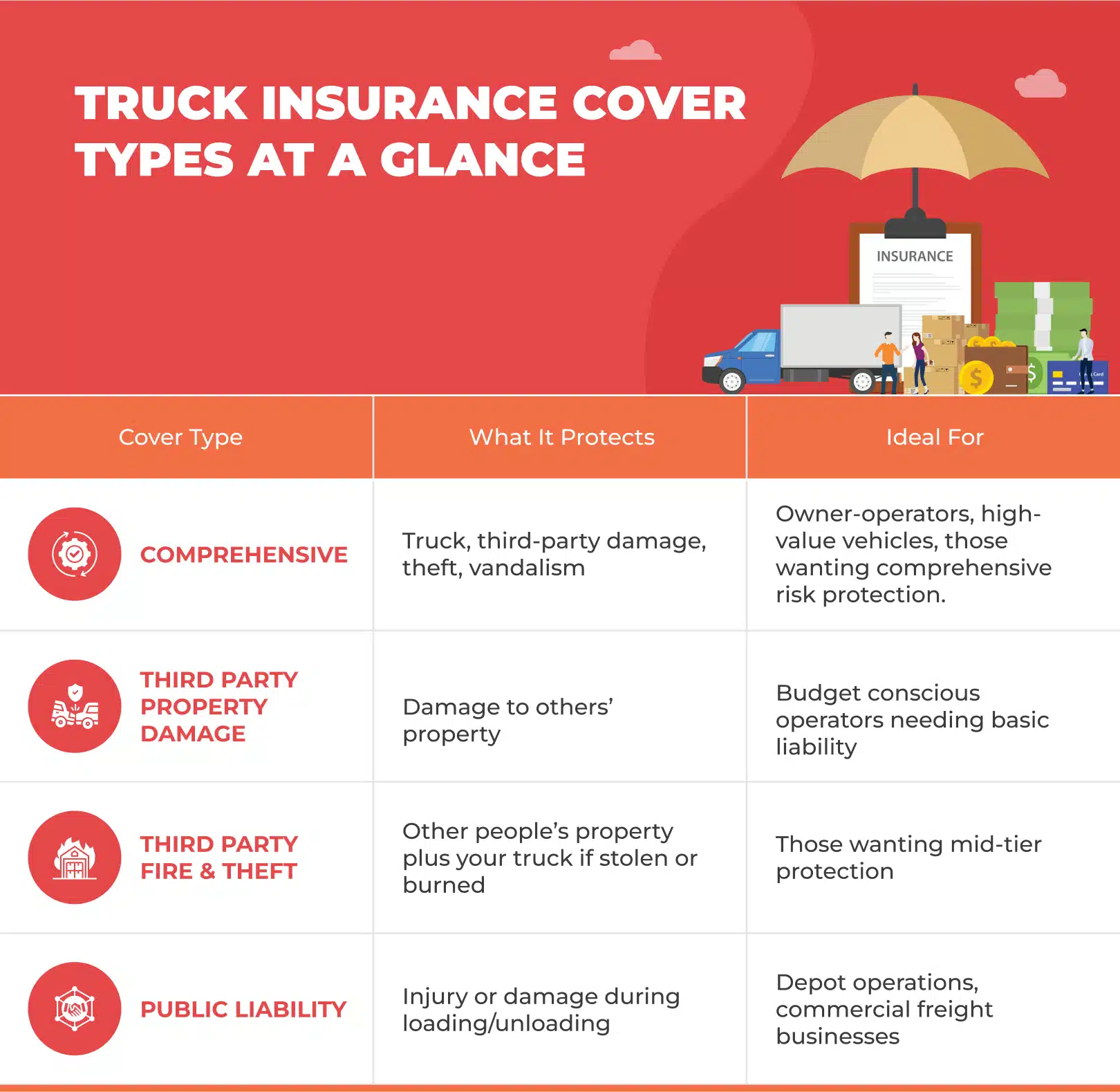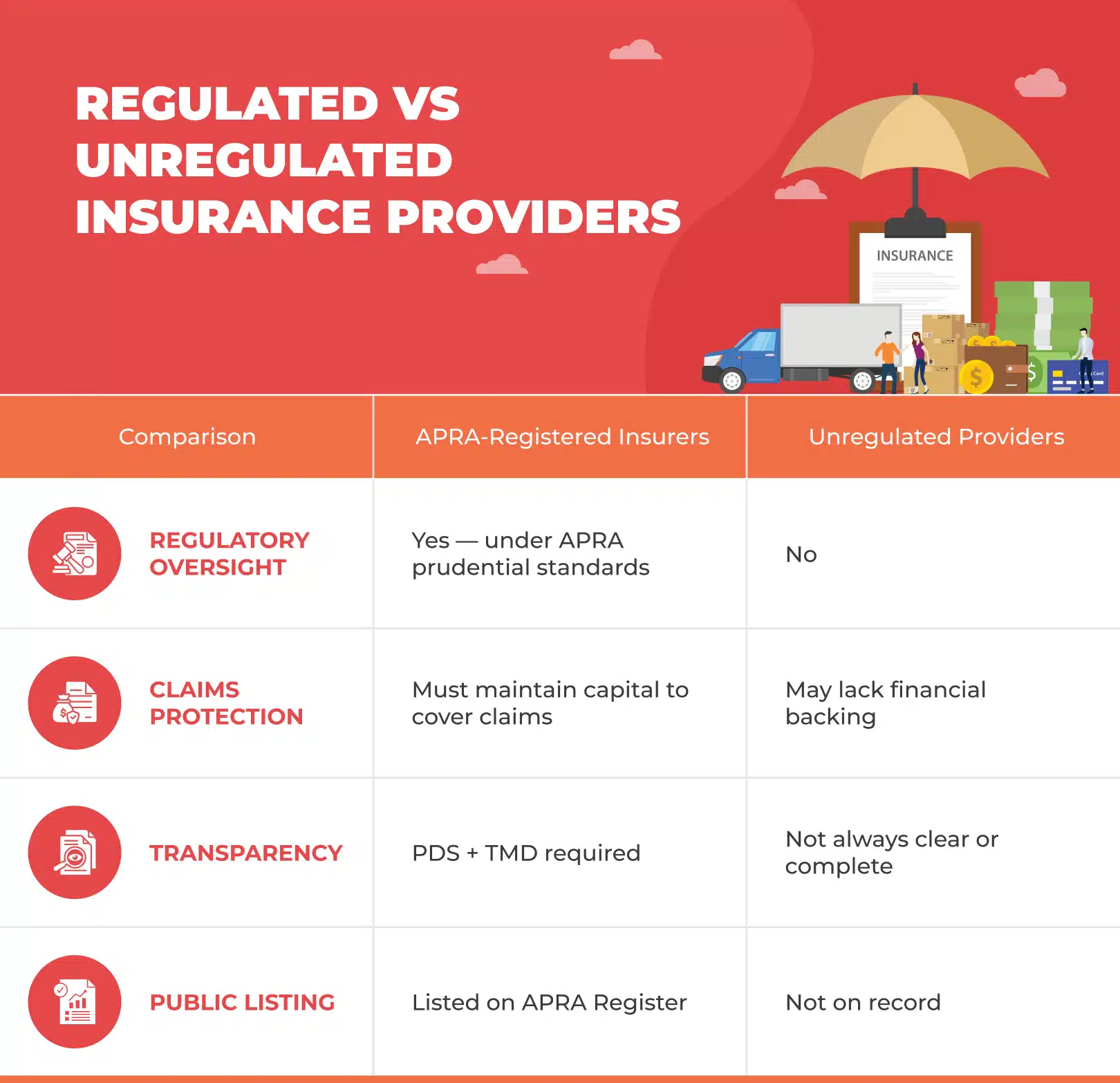Comprehensive Food Truck Insurance for 2026
Discover unparalleled protection for your food truck insurance needs with VIM Cover’s comprehensive food truck insurance policies. Designed for Australian truck owners, our policies ensure affordability and reliability, keeping you secure on every journey. We offer a rapid quote for approved applicants. Please fill out the form below to receive a fast quote.
Key Takeaways on Food Truck Insurance
- Food trucks face double exposure: road accidents + customer liability.
- A single food poisoning claim can cost thousands in legal fees.
- Equipment breakdowns or food spoilage can stop operations overnight.
- Tailored insurance helps protect cash flow and keeps you compliant.
- VIM Cover offers customised policies with fast claims support.
Food trucks face risks beyond the kitchen. A road accident can damage your vehicle and equipment, spoiled stock can wipe out profits, and legal fees can be incurred in cases of food poisoning or other allergies. Unlike restaurants, food trucks are exposed to both road mishaps and other safety liabilities. These uncertainties make it essential to have a more business-focused and personalised insurance, which allows you to run your business with minimal worry. The right cover not only protects your cash flow and keeps you compliant but also ensures your mobile business stays open after an unexpected setback.
Why Food Truck Insurance is Crucial for Your Business?
Unlike a fixed restaurant, your food truck is both your motor vehicle and your business premises, meaning you carry double the exposure on the road and in service. That's why the right food truck insurance isn't optional; it's essential. Also, it's equally important to have the right type of insurance that matches your business and its running.
For operators, it’s worth noting that insurers in Australia must meet regulatory standards set by APRA (Australian Prudential Regulation Authority), ensuring you’re dealing with a licensed and compliant provider. This gives food truck owners confidence that their policy is backed by a regulated and trustworthy insurance company.
Unique Risks Food Trucks Face
It includes:
- Accidental damage - This includes vehicle damage, such as a minor prang, or even if a vehicle is written off, including accidental damage to cooking equipment, which prevents any immediate service.
- Food poisoning & personal injury – Costly legal claims can arise due to foodborne illness or a slip near your service window.
- Food spoilage & equipment breakdown – If your fridge fails overnight or your generator cuts out at a festival, spoiled stock is money lost.
- Legal liability – Every public interaction, from parking in crowded areas to serving hot food, exposes you to potential compensation claims.
- Optional covers – Extra protection, such as cash flow cover, can keep bills paid if downtime stops you from trading.
How Insurance Protects Operators?
Let's understand some of the standard insurances:
- Personal accident & workers' compensation covers truck owners and their staff in case of mishaps, which include burns, cuts, or other injuries sustained while at work.
- Medical expenses & legal costs – In case a customer sues over injury or illness, your business insurance policy can handle the hospital bills and lawyer fees.
- Insurance claim support – A good provider ensures that claims for insured events, such as theft, breakdowns, or accidents, are processed quickly, thereby reducing downtime.
- Peace of mind for operators – With cover in place, food truck owners can focus on what matters most: serving customers and growing the mobile business without the constant worry of "what if."
Types of Insurance Packages for Food Truck Owners
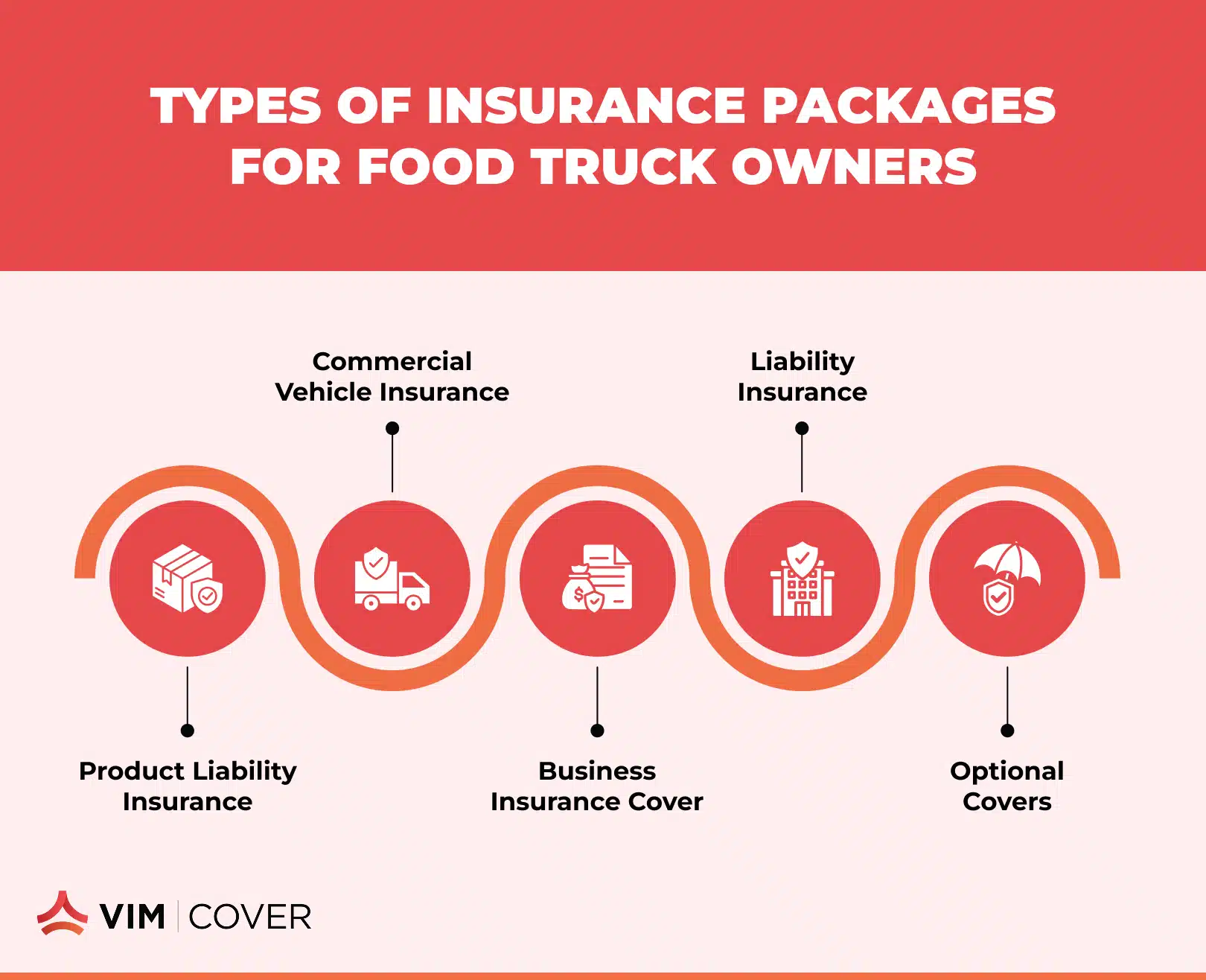
Product liability insurance protects against claims of:
- food poisoning
- allergic reactions
- Covering legal fees and compensation.
Commercial vehicle insurance covers:
- the truck itself,
- repairs after accidental damage,
- fit-out and cooking equipment inside.
Business insurance cover extends to:
- stock, cash
- portable equipment
- losses from theft, fire, or food spoilage.
Liability insurance protects against:
- Legal costs if a customer or third party suffers personal injury
- Property damage during the course of business activities.
Optional covers, such as equipment breakdown or downtime protection, help:
- stabilise income when generators fail
- fridges stop working
- You are unable to operate due to an insured event.
It's advisable to read and understand policy wordings and Product Disclosure Statements before signing up for any particular insurance cover to avoid claim issues.
How VIM Cover Provides Superior Insurance Solutions?
We understand that no two mobile food trucks are alike and have specific business needs. Irrespective of whether you run a coffee van, a gourmet burger truck, or a multi-vehicle fleet, customisable insurance packages allow you to pick and choose the level of accidental loss you would like to cover. We offer a rapid quote for approved applicants. Please fill out the form below to receive a fast quote.
Unlike one-size-fits-all insurance providers, we work through experienced insurance brokers who focus on understanding your day-to-day risks. Based on your business operations, we suggest that you opt for comprehensive cover that extends to business premises, staff, and broader business activities. Our flexible cover options let you choose the best for your business.
What sets us apart from many insurance companies is our fast and transparent claims process. Food truck operators don't have time for paperwork delays; their streamlined approach ensures you're back on the road as quickly as possible. The policy terms are written to reflect the realities of mobile businesses, avoiding unnecessary coverage and reducing higher premiums that other providers often charge.
Protect Your Mobile Food Business with the Right Coverage
A tailored business insurance quote from VIM Cover ensures you only pay for what truly matters — no unnecessary extras, just the right cover for the risks your food truck faces daily. Policies are designed around your actual operations, whether you run a coffee van with portable generators, a gourmet burger truck with high-value cooking equipment, or a fleet serving significant events.
Coverage can extend to:
- Breakdowns & spoilage – protection when fridges, freezers, or generators fail.
- Liability claims – cover for food poisoning, personal injury, or property damage caused during service.
- Business interruption – income support when an insured event forces you to stop trading.
By securing a plan built for your business model, you safeguard cash flow, meet legal liability requirements, and keep your mobile business operational with minimal disruption. Protection is not just compliance; it's a guarantee that you can stay on the road and serve customers with peace of mind.
FAQs About Food Truck Insurance with VIM Cover
- Does food truck insurance cover both the vehicle and kitchen equipment?
Yes. With VIM Cover, policies can bundle commercial vehicle insurance with coverage for cooking equipment, refrigeration, and fit-outs, ensuring your entire mobile setup is protected under one plan.
- What happens if food spoilage occurs due to a power failure?
Food spoilage caused by equipment breakdown or power outages can be included in your policy. VIM Cover helps you recover costs so your cash flow isn't disrupted.
- Can I insure multiple food trucks under one policy?
Absolutely. VIM Cover offers fleet policies for operators with multiple trucks, making it easier and often more affordable to manage insurance for your mobile business.
- How does VIM Cover handle claims for food poisoning incidents?
If a customer files a claim for food poisoning or personal injury, your liability coverage will take effect. VIM Cover ensures a transparent and fast claims process, minimising downtime and legal costs.
- Are there flexible insurance options if I only operate seasonally?
Yes. VIM Cover can tailor cover options for seasonal food truck operators, so you're only paying for the protection you need when your business is active.
**This article provides general information only and does not take into account your specific circumstances. You should seek advice from a licensed insurance professional before making decisions.
Comprehensive Commercial Truck Insurance Guide for 2026
Key Takeaways about Commercial Truck Insurance
- Protects business vehicles and drivers from major risks.
- Covers accidents, liability, downtime, and natural disasters.
- Flexible options: comprehensive, third-party, and add-ons.
- Extra cover: life, property, transit, and roadside support.
- VIM Cover delivers fast quotes and tailored solutions.
Running trucks for business isn’t simple. Breakdowns, accidents, and even weather events can affect businesses and their operations, often causing delays in deliveries and other regular activities. It also leads to a lot of back-and-forth to get things on track. That’s why having commercial truck insurance is more than just meeting a requirement on paper; it’s about protecting your people, your trucks, and your cash flow.
At VIM Cover, we work with businesses across Australia to make sure they’re not left exposed. The right cover means fewer worries and a faster recovery when things don’t go as planned.
Why Commercial Truck Insurance Matters?
Protecting Business Operations
If your trucks are on the road for business purposes, you’re carrying risk every kilometre. Good cover ensures:
- Business vehicles are protected if damaged or written off.
- Truck drivers and owner-operators can work with peace of mind.
- Major risks like accidental damage, public liability, or third-party property damage don’t turn into major financial losses.
Key Benefits of the Right Coverage
A firm insurance policy does more than replace a damaged truck. It helps your business stay steady when unexpected costs hit.
- Financial protection – Keeps your cash flow intact when repair or replacement bills arrive.
- Risk coverage – From natural disasters to accidents involving dangerous goods.
- Downtime cover – Helps with income loss if a truck is off the road.
- Business continuity – Support during claims so your operations don’t stall.
Types of Commercial Insurance for Trucking Businesses
Core Options
- Comprehensive or complete insurance – Covers physical damage, accidental damage, and total loss.
- Third Party Property Damage – Protects against damage claims from others.
- Roadside assistance – Reduces costly delays if a truck breaks down.
- Prime mover cover – Designed for high-value vehicles critical to freight.
Add-Ons and Extras
Depending on your setup, you may also need:
- Life insurance for owner-operators.
- Property insurance for depots or warehouses.
- Marine cargo insurance if your transport extends offshore.
- Custom options based on carrying capacity and mixed personal use.
How to Choose the Right Commercial Truck Insurance Policy for Your Business Needs
Step 1: Match Commercial Truck Insurance Cover to Your Business Activities
Think about:
- The risks in your line of work (long-haul, dangerous goods, interstate freight).
- What’s already included in your policy documents?
- Your driving history and financial situation both affect premiums.
Step 2: Pick a Reliable Insurance Provider
Not all insurance companies cover the requirements of truck insurance. Before you decide:
- Compare truck insurance quotes across providers.
- Look for insurers with experience in transport and strong claims support.
- Ask for clear Target Market Determination (TMD) documents to ensure the policy is designed for businesses like yours.
How Commercial Truck Insurance Protects Your Business
Comprehensive Risk Management Solutions
The right commercial truck insurance is a key component of innovative risk management. It:
- Shields you from compensation claims and third-party liability.
- Covers accidental damage or total loss.
- Keeps operations running with superior claims service and access to replacements.
- Provides tailored solutions so you don’t pay for cover you don’t need.
Compliance and Business Continuity
Insurance is about protection while your trucks are on the go, as well as staying compliant with state laws and avoiding unwanted losses. Policies that meet Target Market Determination guidelines and address specific business needs help keep you aligned with state regulations. This reduces legal risks while ensuring your trucks have the right insurance cover.
Why Partner with VIM Cover? Your Right Commercial Truck Insurance Partner
We specialize in policies that work for real businesses, not cookie-cutter solutions, and our insurance covers ensure adequate liability coverage for your trucks tailored to their specific needs. We help you:
- Find cover that fits your business use and vehicle types.
- Add extras like downtime cover or roadside assistance when needed.
- Get a truck insurance quote in just 60 minutes for eligible applicants. That means in case of emergencies, when you require the right coverage or comprehensive insurance for your truck, we are here to assist you.
- Rely on a team that supports you through the claims process.
Many business owners also wonder, Are business vehicles more expensive to insure? The answer depends on factors such as vehicle type, usage, and risk profile, which can significantly impact insurance costs.
We offer customised commercial truck insurance policies, flexible cover options, and, for approved applicants, a fast 60-minute quote service to keep your business moving without downtime.
FAQs – Commercial Truck Insurance with VIM Cover
Q: How quickly can I get a truck insurance quote with VIM Cover?
We know time matters in business. That’s why VIM Cover offers a rapid turnaround on most truck insurance quotes, so you’re not stuck waiting.
Q: Does VIM Cover provide cover for dangerous goods?
Yes. Our policies can be tailored for the transportation of dangerous goods, ensuring you stay protected while meeting compliance requirements.
Q: Can I insure a mixed fleet under one policy?
Absolutely. Whether you run prime movers, delivery vans, or light trucks, we can customise cover for a wide range of vehicle types and carrying capacities under a single policy.
Q: What if my truck breaks down or is off the road?
We offer downtime coverage and roadside assistance options, helping to reduce income loss and keep your business operations steady during unexpected repairs.
Q: Does VIM Cover only provide truck insurance?
No. Alongside comprehensive truck insurance, we also offer a range of additional products, including business insurance, property insurance, public liability insurance, and transit insurance, to provide you with complete protection for your business and personal needs.
Q: Why choose VIM Cover over other insurance providers?
Unlike generic insurance companies, we focus on the trucking industry. That means tailored advice for the type of insurance based on your requirements, flexible extras, fast quotes, and hands-on customer support during the claims process.
**This article provides general information only and does not take into account your specific circumstances. You should seek advice from a licensed insurance professional before making decisions.
Comprehensive Light Truck Insurance Guide for 2026
At VIM Cover, we understand that every light truck operator has different needs, whether you’re moving goods across town, running a fleet of goods-carrying vehicles, or transporting dangerous goods. That’s why we offer customised light truck insurance policies, flexible cover options, and, for approved applicants, a fast 60-minute quote service to keep your business moving without downtime.
Key Takeaways:
- Light truck insurance is essential for goods-carrying vehicles up to 4.5 tonnes GVM, protecting against theft, damage, liability, and downtime losses.
- VIM Cover offers customised policies with optional add-ons like downtime cover, transit insurance, and dangerous goods protection.
- The right policy offers peace of mind with vehicle coverage, theft protection, accident liability, and business continuity support.
- Understanding your vehicle type, cargo value, and business operations is key to selecting the right level of coverage.
- VIM Cover’s 60-minute quote service ensures fast, tailored insurance solutions for businesses of all sizes.
- Bundling your truck insurance with life, travel, or home insurance can enhance your protection strategy.
- Opting for a provider like VIM Cover, known for transparency and strong support, can improve your claims experience.
What Is Light Truck Insurance?
Light truck insurance is designed for goods-carrying vehicles with a specific carrying capacity, which is often up to 4.5 tonnes GVM and can be personalised for business use or personal purposes. It protects you from accidental damage, theft, property damage to other people’s property, and even total loss of your vehicle.
For businesses, this type of cover isn’t just a compliance tick; it’s a safeguard that keeps business vehicles on the road and earning a stable income (in case of any mishap), even after an insured event.
Understanding Light Trucks and Insurance Needs
Light trucks are versatile workhorses (as they call it) that range from delivery vans to small tippers, and their insurance needs vary from heavy commercial trucks. Policies are built to reflect:
- The carrying capacity and type of vehicle.
- Frequency and nature of business activities.
- Whether they carry dangerous goods, operate as mobile plant, or are used for mixed personal and business purposes.
An effective truck insurance policy ensures you’re covered for real-world risks, not just what’s written on paper.
Key Features of Light Truck Insurance
A strong, comprehensive truck insurance policy can include:
- Comprehensive cover for your vehicle and your property.
- Theft cover and accidental loss protection.
- Downtime cover to support your cash flow while your truck is off the road.
- Compensation claims for personal injury or damage caused to others.
The level of cover you choose will determine how well you’re protected when it matters most.
Why Businesses Need Light Truck Insurance?
Supporting Business Vehicles and Operations
For transport operators and owners of goods-carrying vehicles, light truck insurance is more than a formality. It’s essential for keeping operations running, especially when dealing with dangerous goods or time-sensitive and/or perishable goods delivery.
During an insured event, having the right cover can help with repair costs, replacements, and even provide a temporary hire vehicle to keep jobs moving.
Small Business Insurance Benefits
Many insurers offer small business insurance packages that combine comprehensive coverage for trucks with other insurance products. These can be customised for:
- Specialised freight
- Mobile plant transport
- High-value goods
- Multi-vehicle fleets
It’s not just about protection, it’s about peace of mind for owners and employees.
Choosing the Right Light Truck Insurance Policy
Factors to Consider
Before selecting a truck insurance policy, weigh your:
- Type of vehicle and carrying capacity.
- Driving history and risk profile.
- Level of cover, including downtime cover and comprehensive coverage.
- Specific clauses in the Policy Wording and relevant Product Disclosure Statement.
Working with Insurance Brokers and Providers
An experienced insurance broker can help you clearly understand the aspects of the insurance, cut through the jargon, compare cover options, and match you with an insurance provider that fits your financial situation and specific needs. Choose providers with a clear Target Market Determination and responsive customer support to guide you through the claims process.
Additional Insurance Products to Consider
For businesses looking to protect more than just their trucks, pairing your commercial motor cover with other insurance products can strengthen your safety net:
- Home insurance – To protect personal property from damage or theft.
- Travel Insurance – For business or personal trips involving valuable goods.
- Boat Insurance – For commercial or personal watercraft.
- Life Insurance – Ensures financial stability for your family or business partners if the unexpected happens.
- Transit insurance – Covers goods in transit from pickup to delivery.
Ready to protect your business?
Get a customised VIM Cover light truck insurance quote in under *60 minutes. Speak to our team today for personalised cover recommendations.
Protecting Your Business with the Right Cover
The right policy cushions your business from costly disruptions and keeps operations running smoothly. It’s about matching insurance to the real risks you face, not paying for what you don’t need.
- Downtime cover to offset income loss during repairs
- Protection for high-value or sensitive cargo
- Add-ons for dangerous goods and mobile plant
- Policy terms that fit your vehicle type and workload
Learn more about how to get a truck insurance quote in 2026.
Why Choose VIM Cover for Light Truck Insurance?
When it comes to protecting your business vehicles, you need more than just a standard policy; you need a partner who understands the risks and challenges you face every day.
VIM Cover offers:
- Comprehensive truck insurance for a wide range of vehicle types and carrying capacities.
- Flexible extras like downtime cover, transit insurance, and customised policy wording for your specific needs.
- A proactive and responsive customer support.
- Our 60-minute turnaround for quotes for qualifying applicants.
Schedule an appointment with us today!
FAQs – Light Truck Insurance
Q: Can I get a light truck insurance quote quickly with VIM Cover?
Yes. In certain circumstances, VIM Cover offers a 60-minute rapid quote service so you can get insured without delays.
Q: Does VIM Cover offer cover for dangerous goods or mobile plant vehicles?
Absolutely. Our truck insurance policies can be tailored for dangerous goods, mobile plant, and other specialised uses.
Q: What makes VIM Cover different from other insurance providers?
We combine comprehensive coverage with personal service, flexible policy design, and fast turnaround times, all while ensuring your specific needs are met.
Q: Can I bundle my light truck insurance with other products at VIM Cover?
Yes. You can combine your truck cover with options like home insurance, travel insurance, or life insurance to protect more of what matters to you.
**This article provides general information only and does not take into account your specific circumstances. You should seek advice from a licensed insurance professional before making decisions.
How to Get a Truck Insurance Quote in 2026?
Key Takeaways:
- What’s included in a truck insurance quote (and what’s not).
- The difference between Comprehensive cover, Third Party Property Damage, and other policy types.
- How factors such as vehicle type, cargo, and business use affect your price.
- Add-ons like downtime cover and transit insurance can save you when things go wrong.
- How to compare insurance providers and read the fine print before you sign.
- What to expect during the claims process and how to avoid delays.
If you own a truck or manage a fleet, insurance isn’t optional; it’s essential. In 2026, getting a truck insurance quote is more than just filling out forms. Insurers assess what you drive, how you use it, and your claims history before offering cover. And you can compare offers only from APRA‑authorised insurance companies to make sure your provider meets national standards.
Want a Quote in 60 Minutes?
If you’re short on time, we offer a 60-minute rapid quote turnaround for eligible businesses. That means less waiting, more peace of mind, and faster protection for your truck or fleet.
Get your truck insurance quote in under 60 minutes here!
What is Included in a Truck Insurance Quote?
Most insurance companies include several critical components in your quote. Review the Insurance Council of Australia guidelines to understand industry best practices for commercial motor insurance, including how risks like property damage and liability are handled.
Most insurance companies will include the following in your truck insurance quote:
1. Type of Cover
You’ll typically choose from a few key policy types:
- Comprehensive cover – Covers your truck for theft, accidental damage, vandalism, and property damage to others, even if the accident was your fault.
- Third Party Property Damage – Protects you if your vehicle causes damage to someone else’s vehicle or property, but not your own.
- Third Party Fire and Theft – A balance between cost and protection, covers others' property, plus fire or theft damage to your vehicle.
You may also consider Public Liability Insurance, Compulsory Third Party (CTP), or Third Party Insurance, depending on your operations and state requirements.
2. Business Use and Specific Activities
Your quote reflects how and where you operate:
- Local, regional, or national transport
- Dangerous goods, refrigerated goods, or mobile plant operations
- Business-related storage or depot details
Your business use directly affects pricing and eligibility.
3. Vehicle Information
Insurers evaluate:
- Truck make, model, age
- Carrying capacity
- Whether you operate light trucks, rigid trucks, or prime movers
- Modifications like mobile cranes, tail lifts, or onboard computers
Accurate info ensures a valid quote and helps avoid policy disputes.
4. Driving & Claims History
Your driving history, past claims history, and even your financial situation play a role in determining premium levels and excess options.
Operators with strong safety records often access lower premiums or better coverage limits.
5. Optional Benefits and Add-On
Coverage options like Transit Insurance or Downtime Cover are standardised across the Australian insurance market. Understanding typical definitions and claims processes is easier when referring to the Insurance Council of Australia’s guidance.
6. Policy Inclusions, Costs, and Documentation
Every quote includes:
- A detailed premium (monthly or annually)
- Breakdown of inclusions and exclusions
- Every quote should point you to a Product Disclosure Statement and a Target Market Determination, as insurers must follow APRA’s prudential standards for general insurers regarding transparency and governance.
- A clear Target Market Determination
- Your rights to general and personal insurance advice
Understanding your policy wording and the full scope of your cover is essential before committing.
Understanding Truck Insurance Coverage
A truck insurance quote typically includes one or more of the following cover types:
Comprehensive Cover
Covers your truck for accidental damage, theft, fire, and property damage to others. It’s ideal if your truck is essential to your income or is of high value.
Third Party Property Damage & Public Liability
Essential if your truck damages someone else’s vehicle or property. Public liability insurance covers incidents involving injury or damage during loading, unloading, or delivery.
Add-Ons That Matter
Depending on your business, you can include:
- Downtime cover – income protection if your truck is off the road
- Transit insurance – protects your cargo during transport
- Windscreen, hire vehicle, and legal liability extras
Each policy can be customised to fit your business, from a single light truck to a fleet of prime movers.
Additional Insurance Types You May Need
Your truck insurance quote may cover the vehicle, but running a business often involves other risks. Depending on your operations, you might also need:
Travel Insurance for business-related trips
If you or your team regularly travel for work, whether interstate or regional, Travel Insurance can cover unexpected costs like trip cancellations, delays, or personal injury.
Boat Insurance for companies with marine operations
For transport companies that also operate near ports or on water, Boat Insurance protects vessels used for loading, delivery, or marine transport. It’s especially relevant for businesses involved in intermodal freight.
Life Insurance to protect business owners and employees
If you’re a business owner or employ drivers, Life Insurance adds a layer of security for families and teams. It helps protect income, manage business debts, or support succession planning, a valuable asset for small business operators.
Why Truck Insurance Protects Your Business Operations?
Things go wrong. Accidents happen. Trucks break down. A good truck insurance policy makes sure you’re not paying for it all out of pocket.
What the Right Policy Covers
- Covers repair costs and property damage
- Takes care of legal liability if you're at fault
- Downtime cover helps you manage lost income
- Gives owner-drivers and transport operators real peace of mind
What Kind of Vehicles Are Covered?
- Light trucks, rigid trucks, and prime movers
- Work trucks, vans, and business cars under Commercial Vehicle Insurance
- Trucks carrying dangerous goods or fitted with mobile plant
It’s all about keeping your trucks on the road and your business moving.
Factors That Impact Truck Insurance Cost
No two quotes are the same. Your truck insurance cost depends on a few key details that insurers use to assess your risk.
What Insurers Look At?
- Your driving and claims history, and your financial situation.
- The truck’s carrying capacity and how it's used for business activities
- The type of insurance you’re after, Comprehensive cover, Third Party Property Damage, or something in between
- Your financial situation, including the ability to absorb risk
Whether you’re an owner-driver or managing a fleet, these factors shape your premium.
Understanding the Fine Print
Before signing anything:
- Read the Product Disclosure Statement (PDS) for the full details
- Make sure the policy matches your business: check the Target Market Determination (TMD)
- Look into optional benefits that could improve your cover (and increase the cost)
Precise policy wording helps avoid headaches later, especially at claims time.
How to Find the Best Truck Insurance Providers?
With so many insurance companies out there, finding the right fit comes down to knowing what to look for and asking the right questions. You can read our comprehensive guide about Light Truck Insurance for 2026 here.
Steps to Get the Right Coverage
- Always choose insurers listed on APRA’s official register of authorised general insurers. This guarantees they are monitored for financial stability and regulatory compliance.
- Be ready with your personal information, vehicle details, and business needs
- Speak to an authorised representative who can give clear, tailored advice, not just a sales pitch
Insurance Options Beyond Truck Insurance
Depending on your setup, you might need:
- Fleet insurance for multiple trucks or vehicles
- Home Insurance or Landlord Insurance to protect business-related properties
- Home Buildings coverage for owner-operators running from home
Get cover that fits your life, not just your truck.
Tips for Navigating the Truck Insurance Claims Process
Accidents happen. When they do, understanding the claims process can save you time, stress, and money.
What to Expect During Claims?
- For events like accidental loss, total loss, or property damage, your insurer will walk you through the required steps.
- You may need to submit documents, evidence, or repair quotes, stay organised.
- Liability claims and compensation claims can take longer, especially if third parties are involved.
Many insurers now offer a streamlined process online, and some (like VIM Cover) even assign a dedicated claims team to support you.
Importance of General Advice and Customer Support
- Reliable Customer Support can make or break your experience, especially during stressful situations.
- Seek general advice before committing to a policy or during a claim if you're unsure of your next step.
- Go with a provider that offers a wide range of insurance solutions, so you’re not left uncovered when it matters most.
It’s not just about getting your truck fixed. It’s about getting back on the road with confidence.
Types of Trucks Covered Under Commercial Vehicle Insurance
Whether you're hauling freight across states or running tools between worksites, your policy should match your vehicle type.
Here's what most commercial truck insurance policies can cover:
- Light trucks – often used by tradies, couriers, and small business owners
- Rigid trucks – ideal for local deliveries, moving services, or specialist freight
- Prime movers – used for long-haul freight, heavy haulage, and intermodal operations
- Mobile plant & mobile cranes – often used in construction and industrial settings
- Vehicles carrying dangerous goods require more tailored risk assessments
A quality Truck Insurance Policy should reflect how your vehicles are used for business purposes and the risks they face day-to-day.
Transit Insurance: Do You Need It?
If your trucks are carrying cargo, Transit Insurance can be a game-changer.
It covers accidental damage, theft, or loss of goods while in transit, which is especially crucial for freight companies and owner-drivers transporting high-value cargo or working with fragile or perishable items.
You can also extend this cover to include:
- Natural disasters (flood, fire, storm)
- Theft while parked overnight
- Third-party Fire and Theft for high-risk routes
Is Fleet Insurance Better for Growing Businesses?
Running more than a few vehicles? Fleet Insurance can often provide:
- Bulk discounts across all registered vehicles
- Easier renewals with one policy, not ten
- Streamlined claims and admin
Fleet cover is ideal for transport operators, logistics businesses, and companies with business vehicle insurance needs across multiple locations or drivers.
Even small businesses with just three or four trucks can often access entry-level fleet solutions.
Do You Need Life Insurance as a Truck Operator?
It might not be the first thing on your mind, but if you're an owner-driver, business partner, or running a transport company, Life Insurance matters.
- It protects your family or business if something happens to you
- Can be bundled with other products (like Travel Insurance and Boat Insurance) if your operations involve different risk areas
Many insurance providers now offer business-focused life cover with flexible options based on your risk level and financial situation.
Secure the Right Truck Insurance Quote for Your Business
Getting the right truck insurance quote shouldn’t take hours or guesswork. At VIM Cover, we make the process fast, clear, and built for your business.
Whether you run one prime mover or manage a whole fleet, we’ll help you find the right balance of cost, coverage, and compliance. Our tailored options protect against accidental damage, property damage, lost income, and legal liability, with add-ons like Downtime Cover, Transit Insurance, and Fleet Insurance when needed.
We also know your time is valuable. That’s why we offer a 60-minute quote turnaround, no hassle, no hold-ups. Get started now.
FAQs
1. How fast can I get a quote from VIM Cover?
In certain circumstances, you’ll receive your quote in under 60 minutes, tailored to your vehicle type and business needs.
2. Is Downtime Cover worth it?
Yes, it helps you recover lost income while your truck is off the road due to repairs or damage.
3. What trucks can I insure?
We cover light trucks, rigid trucks, prime movers, and vehicles transporting dangerous goods or mobile plant.
4. What factors affect my insurance cost?
Your driving history, claims history, business use, and carrying capacity all influence your truck insurance cost.
5. What is a Target Market Determination?
It outlines the intended recipients of the policy. Always review the Target Market Determination and policy documents before making a purchase.
6. Can I insure multiple vehicles under one policy?
Yes, our Fleet Insurance solutions make it easy to manage cover for several trucks at once.
7. Will my policy cover legal fees?
Most policies cover legal liability, including third-party claims for property damage or personal injury.
8. Can I get help choosing a policy?
Absolutely. Our team offers general advice and support to help you make the right call. You can contact us by either filling out the form or giving us a call.
**This article provides general information only and does not take into account your specific circumstances. You should seek advice from a licensed insurance professional before making decisions.
Understanding Insurance for Service Businesses
Why Understanding Insurance Matters for Service Based Businesses
Whether you offer consulting, accounting, hairdressing, graphic design, IT support, or any kind of professional service, insurance forms a critical part of your business’s stability. Clients rely on your expertise, and you depend on a world of trust and relationships — but what protects you when things don’t go as planned? The answer is comprehensive, fit-for-purpose insurance.
Service businesses face unique risks. A wrong recommendation, unintended copyright infringement, or client dissatisfaction can quickly spiral into expensive legal battles. Even something as simple as a client slipping on your premises can threaten hard-earned revenue. An unexpected incident may disrupt your ability to deliver services altogether. Insurance helps you manage these uncertainties so you can focus on growing your reputation and serving your clientele without unnecessary worry.
Why service-based businesses need insurance
Professional agility is one thing; professional security is another entirely. No matter how skilled or careful, every services business is exposed to risk. It’s easy to assume that “insurance” is just for brick-and-mortar businesses who deal with inventory or physical products, but that view can leave service providers dangerously exposed.
A dissatisfied client could allege professional negligence. Sensitive client data could be hacked, resulting in a privacy breach. Someone could visit your office, trip on a loose carpet, and be injured. Without insurance, each of these examples could cause disruption, loss of income, and even legal liability that threatens your livelihood.
Consider these common misperceptions:
- “We just give advice, there’s nothing that can physically go wrong.”
- “My client base is loyal, I don’t expect them to sue.”
- “I work from home, so risk is minimal.”
Unfortunately, court cases and complaints don’t distinguish between intentions and outcomes. A single client misunderstanding, system hack, or oversight can bring intense financial stress. Insurance is about safeguarding your business so you can deliver professional services confidently.
Key types of insurance for service-based businesses
Just as no two service businesses are identical, insurance solutions aren’t one-size-fits-all. Here’s a rundown of the main types you should consider:
Professional indemnity insurance
This is the cornerstone for most consultants, advisors, and professionals. It protects you if a client alleges that your advice or service caused them financial loss, either through error, omission, or negligence.
Common claims covered:
- Advice deemed erroneous that leads to a client’s monetary loss
- Accidental breach of copyright or confidentiality
- Defamation related to your services
- Loss of client documents entrusted to you
Some industries require professional indemnity insurance by law or regulation — such as accountants, lawyers, financial advisors, and some allied health practitioners.
Public liability insurance
This covers third-party injury or property damage that occurs as a result of your business activities. For instance, a client might slip and hurt themselves at your workplace, or you accidentally damage something while visiting a client.
While public liability may seem like “retail business” cover, it’s vital for service businesses who engage with clients in person — even if only occasionally.
Cyber liability insurance
Service businesses often hold sensitive client data. Cyber liability deals with the risks of hacking, cyber-theft, or accidental release of private information.
Covers events like:
- Data breaches involving client records
- Ransomware and email scams
- Losses from unauthorised electronic fund transfers
General business insurance won’t typically cover cyber-related incidents, making this increasingly essential.
Business interruption insurance
Events beyond your control — like storm damage, fire, or theft — can prevent you from servicing clients, sometimes for weeks or months. Business interruption covers loss of income so your business survives while you get back on your feet.
Management liability insurance
This is relevant once your service business expands or you run a company structure with directors. It protects personal and company assets in the case of management-related claims, workplace disputes, or regulatory penalties.
Portable equipment insurance
Service professionals sometimes work with valuable tech, tools, or equipment outside the office — think laptops, cameras, or medical devices. Portable equipment cover insures these against loss, theft, or damage.
Typical insurance needs by service sector
Insurance priorities vary by profession, but some overlaps are universal. Here’s a simplified table to illustrate typical needs:
| Service Sector | Professional Indemnity | Public Liability | Cyber Liability | Business Interruption | Equipment Cover |
|---|---|---|---|---|---|
| Accounting/Finance | ✔️ | ✔️ | ✔️ | ✔️ | ✔️ |
| Legal | ✔️ | ✔️ | ✔️ | ✔️ | ✔️ |
| IT/Tech Support | ✔️ | ✔️ | ✔️ | ✔️ | ✔️ |
| Creative/Design/Media | ✔️ | ✔️ | ✔️ | ✔️ | ✔️ |
| Health & Wellness | ✔️ | ✔️ | ✖️ | ✔️ | ✔️ |
| Consultancy/Advisory | ✔️ | ✔️ | ✔️ | ✔️ | ✔️ |
| Trades (Service-only) | ✔️ | ✔️ | ✖️ | ✔️ | ✔️ |
Not every business needs every type, but this provides a starting point for considering where your business faces greatest exposure.
Assessing your risks
Assessing which insurance you need starts with a careful look at your activities and obligations. No two businesses face identical risks, but common questions help clarify your unique profile:
- Who are my clients, and what promises do I make to them?
- Do I handle confidential information or client data?
- Do I work at client sites or welcome visitors?
- What technology or specialised equipment do I rely on?
- What would happen if my premises were inaccessible for a week?
- Am I exposed to claims about my work quality, accuracy, or conduct?
- Are there regulatory requirements or client contract terms mandating specific covers?
By mapping out the services you provide and the way you interact with clients, you paint a clear picture of where you may be vulnerable. It also helps avoid paying for unnecessary cover.
How much insurance cover is enough?
Under-insuring is risky, but over-insuring ties up capital unnecessarily. Finding the right balance requires thinking beyond headline policy limits. Some key factors include:
- The size and complexity of your contracts
- Industry standards or legal minimums
- Value of equipment and assets
- Potential legal defence and settlement costs
- Duration your business could survive a disruption without income
Ideally, insurance should be tailored. Discussing your specific risk factors with a broker or insurance adviser can help fine-tune levels, especially where clients or government expect set minimums.
Common pitfalls and how to avoid them
Insurance for service providers has plenty of nuances. Some common mistakes trip up even experienced operators:
- Ignoring contract terms: Many larger clients or government contracts specify insurance types and limits. Overlooking these can cost you contracts or expose you to claims.
- Assuming home-based businesses don’t need cover: Running a service business from your home doesn’t exempt you from risks — and most personal insurance policies exclude commercial use.
- Not updating insurance as the business grows: Expansion, new services, or hiring staff all change your risk profile. Annual reviews ensure your cover keeps pace.
- Failing to disclose full activities to insurers: Not telling your insurer exactly what you do (all the services you offer, where you operate, etc.) can void policies if you ever claim.
The relationship between risk management and insurance
Insurance is your financial backup; risk management is what prevents claims in the first place. They work hand in hand.
Service business owners should embed simple practices to reduce common exposures. These include:
- Clear, written client agreements spelling out what you’re responsible for
- Maintaining professional credentials and keeping skills sharp
- Regular technology and cybersecurity updates
- Confidentiality and document management protocols
- Procedures for safely greeting clients and visitors
Implementing practical controls can limit the likelihood of incidents and support your case if you do need to claim.
Adapting your cover as things change
Your business rarely stands still. Insurance needs shift as you:
- Diversify your services
- Hire more staff or contractors
- Invest in new technology
- Land bigger clients or contracts
- Move offices or go fully remote
Annual insurance checkups should become routine, just like tax or compliance reviews. These keep your cover fit for purpose so you’re not caught short if things go sideways.
Working with insurance advisers and brokers
Navigating insurance products and wordings can feel like a maze. For many service businesses, building a relationship with a broker or adviser is money well spent.
Brokers help identify gaps, explain policy conditions, and negotiate on your behalf — especially valuable if need to claim. Their insights into industry-specific risks are drawn from real-world experience, helping you avoid the most common (and costly) pitfalls.
Don’t be afraid to ask direct questions about exclusions, waiting periods, or policy conditions. A trustworthy adviser expects it. Their goal is to help your business thrive, not just sell insurance.
Key takeaways for service business owners
Being a service professional means people trust your knowledge, integrity, and expertise. The right insurance lets you back that up, with confidence. Always be proactive: review your exposure, tailor your policies, communicate openly with your broker or insurer, and update cover as you grow.
At its heart, insurance for service businesses is about more than ticking a compliance box. It provides the resilience you need to keep doing what you do best, even if the unexpected happens. As your business grows, make insurance part of your strategic toolkit — not just an afterthought.
Manufacturing and Engineering Insurance
Manufacturing and Engineering Insurance: Risk Management Essentials
Australian manufacturers and engineering firms operate in a world where progress and risk walk side by side. Machinery hums, innovation thrives, but so do hazards: equipment failures, supply interruptions, cyber threats, and complex liabilities. No matter how robust your systems or safety protocols, unexpected events can derail even the most seasoned operations.
Protecting the heart of your business isn’t just about ticking a regulatory box; it’s a strategic investment in continuity and resilience.
Why Traditional Insurance Falls Short
General insurance policies simply don’t cut it when it comes to the intricate world of manufacturing and engineering. These sectors face an interplay of physical, human, and digital risks that are often unique. Many insurance products were not designed with an advanced CNC facility or a 3D-printed medical device manufacturer in mind.
From precision tooling to global supply chains, the risks are multifaceted:
- Production lines can grind to a halt from mechanical or software failures.
- Intellectual property could be compromised during a cyber intrusion.
- An error in a single engineered component may affect hundreds of downstream users.
- Environmental and pollution incidents could trigger regulatory fines and third-party claims.
So, what does a tailored manufacturing and engineering insurance policy actually cover?
Core Components of a Robust Policy
At the foundation, specialist insurers target both tangible and intangible threats, making these products more sophisticated than standard business packages. Typical covers might include:
| Coverage Type | What It Protects | Why It Matters |
|---|---|---|
| Machinery Breakdown | Physical assets and income loss | Machines are business lifeblood |
| Product Liability | Legal costs, damages | Defective products can result in recalls |
| Business Interruption | Lost income, extra costs | Downtime has a cascading financial effect |
| Professional Indemnity | Errors in design, advice, or plans | Even the best engineers make mistakes |
| Cyber Liability | Data and networks | Attacks can halt operations instantly |
| Environmental Impairment Liability | Pollution events | Manufacturing accidents can be costly |
| Transit and Marine Cargo | Goods in transit | Supply chains often cross national borders |
| Property Damage | Buildings, contents, stock | Fires and weather events threaten assets |
This combination adapts as your business grows, automates, or integrates new technology.
Digging Deeper: Customised Protections
No two facilities or product lines look exactly alike. Insurance programs need to account for the nuance of your machinery, materials, and markets. For example:
- An electronics manufacturer may face acute risks around static discharge and temperature control. Their insurance should include specific endorsements for equipment breakdown and data restoration.
- A precision engineering firm providing components for automotive assembly lines must look at recall cover, protecting against the cost of pulling back defective products across a continent.
- Multi-site operators might require blanket coverage that flexes as stock is moved between locations in Australia or overseas.
These tailored policies are engineered not just to pay claims, but to help companies bounce back swiftly after a disruption.
The Modern Threatscape: Beyond Tangible Loss
Digitalisation reshapes the sector, and with it, fresh challenges. Australian engineering and manufacturing firms now face:
- Sophisticated ransomware attacks that lock down plant control systems.
- Intellectual property risk as design files are shared with global partners.
- Breach of contract disputes arising from software glitches in high-stakes projects.
Insurance now reaches beyond the warehouse floor to digital blueprints, data integrity, and global supply contracts. The sharp increase in cyber events, for instance, makes cyber liability cover non-negotiable for even mid-sized firms.
Case Study: When the Unexpected Happens
Picture a mid-sized manufacturer near Geelong. A power surge damages their main CNC lathe, leading to a three-week halt in production. While repairs are underway, pending orders pile up, overtime rises, and clients express their frustration.
If their insurance is narrowly focused, machinery repair costs may be covered, but the lost income, expedited shipping costs to placate angry clients, and penalty payments may fall outside the policy.
Comprehensive business interruption cover, however, transforms the outcome:
- Lost gross profit during downtime is covered.
- Extra expenses incurred to keep customers happy can be claimed.
- The business sustains its reputation and retains valuable contracts.
Commonly Overlooked Exposures
Many businesses think only in terms of fire, theft, and machinery breakdown. Yet experience shows the less visible risks can be even more damaging:
- A minor production error in an aluminium extrusion triggers a large-scale product recall.
- Environmental exposures from leaks or mistimed waste disposal prompt regulatory scrutiny.
- Contractual disputes arise when finished goods are late due to material shortages.
These scenarios underscore the need to periodically review your policy for exclusions and sub-limits, to avoid an underinsurance trap.
Emerging Coverage Trends for Australian Manufacturers
New legislative frameworks and technology adoption trends continue to reshape the insurance landscape:
- ESG (Environmental, Social & Governance) standards have led to stricter environmental liability requirements.
- The adoption of Industry 4.0 automation calls for breakdown covers that extend to robotics and IoT-integrated systems.
- Supply chain risk management tools are bundled with insurance, giving early warning of a brewing crisis overseas.
- Multinational operations are using master policies with local compliance overlays, harmonising coverage across multiple jurisdictions.
Insurance brokers working exclusively in the manufacturing and engineering sectors now harness data analytics, site risk mapping, and incident simulation tools to build adaptable policies. This arms decision-makers with the insights required to balance risk appetite with cost.
Cost-Saving Strategies Without Cutting Corners
Premiums for these advanced covers can be eye-watering, but there are effective ways to control costs without leaving yourself exposed:
- Invest in preventative maintenance and safety training, which can lower premiums through demonstrable risk reduction.
- Bundle multiple insurance types with one specialist provider for multibuy discounts and coverage clarity.
- Raise deductibles where appropriate, as long as you maintain sufficient liquidity to cover an initial loss.
- Engage periodically with your insurer to update them on equipment upgrades or process improvements—they may view you more favourably at renewal time.
A broker who understands both your business and your sector’s global risk profile is more likely to negotiate the right coverage at a fair rate.
Navigating Claims: How to Prepare Ahead
The difference between a smooth recovery and a drawn-out saga often lies in preparation. Forward-thinking firms:
- Keep digital and hard copies of critical documents such as invoices, maintenance logs, and certifications.
- Map key supply chain dependencies, so that loss adjusters understand business impact.
- Train key staff on claims notification protocols, ensuring all relevant evidence is collected promptly after an incident.
A little groundwork upfront can transform a frustrating experience into a quick and constructive claims resolution.
Top Mistakes to Watch Out For
Even sophisticated manufacturers sometimes get it wrong. Some of the most common pitfalls to avoid include:
- Assuming “one size fits all” business insurance policies are adequate.
- Failing to update policies after process changes or equipment upgrades.
- Overlooking cyber and environmental exposures.
- Ignoring contractual liability extensions demanded by clients or contractors.
Bringing an expert into your corner can provide crucial insight, often uncovering gaps that aren’t visible until a loss occurs.
Questions Business Owners Should Be Asking Themselves
Insurance is never a “set and forget” topic. It’s worthwhile to regularly challenge assumptions with questions like:
- Is my business interruption sum insured based on outdated financials?
- Have we accounted for all locations and their unique risks?
- If a new client requests a higher liability limit, can our current policy flex to meet it?
- Do our IT security protocols satisfy the terms for cyber insurance?
- Are there upcoming regulatory changes in the industries we supply that could leave us exposed?
Periodic reviews, particularly with specialist guidance, can make all the difference.
Industry Insights and Shaping the Future
Australian manufacturers are globalising, automating, and morphing into more data-driven businesses by the year. This modernisation has seen the insurance market respond with new products that reward proactive risk management and fast adaptation.
Firms embedding environmental sustainability, integrated IT controls, and world-class safety regimes are set to benefit with more attractive premiums and higher policy limits. Likewise, those that see insurance as a strategic partner rather than a cost find themselves better positioned to win complex tenders and attract global customers.
Success isn’t just about making things. It’s about safeguarding your ability to keep making, innovating, and delivering—even in the face of uncertainty.
As the future of manufacturing and engineering in Australia grows more complex, so too does the toolkit for managing risk. Structured well, specialist insurance is less an overhead, more the foundation on which sustainable success is built.
Why Hospitality Insurance is Crucial for Your Aussie Business
Why Hospitality Insurance is Crucial for Your Aussie Business
Running a restaurant, café, bar, boutique hotel or even a food truck is as much about crafting memorable experiences as it is about hard work, risk-taking and dealing with the unexpected. Hospitality, more than most industries, feels the pressure from every angle: environmental events, customer expectations, reputational risks, health and safety concerns, and the unpredictable rhythm of seasons. Even the most seasoned professionals have found themselves facing setbacks that came out of nowhere.
Risk management is woven throughout every shift, menu change and event, but some risks are too unpredictable or costly to plan for with process alone. This reality is what makes hospitality insurance not just a safety net but a core part of every serious business plan. Regardless of size or niche, being properly insured can mean the difference between weathering a major challenge or shutting your doors for good.
Understanding the Landscape — What Makes Hospitality Unique
The very nature of hospitality is personal. You’re often dealing with the public directly, people from all walks of life, and sometimes in high volumes or fast-paced environments. Safety, compliance and great service run side by side, but the list of things that can go wrong is extensive:
- A customer slips and sustains an injury on your premises
- Food served results in an allergic reaction
- Unexpected equipment failure spoils thousands of dollars’ worth of stock
- Storm damage, fire, or water leaks force an abrupt closure
- Staff injure themselves at work
- A serious data breach exposes sensitive payment details
These scenarios don’t just result in lost income; they trigger legal challenges, reputational damage, and existential questions. This is why insurance for hospitality businesses stands apart from general business cover.
The Core Types of Hospitality Insurance
Choosing the right cover isn’t always straightforward, as the industry requires several policies working together to fill the unique risk profile each business faces. The most typical policies are:
|
Insurance Type |
What it Covers |
Who Needs It |
|---|---|---|
|
Injury or property damage to others |
All businesses open to public |
|
|
Product Liability |
Issues arising from food or drinks served |
Food & beverage establishments |
|
Property Insurance |
Damage or loss to building and contents |
Bars, cafés, restaurants, hotels |
|
Loss of income due to closure from covered events |
All hospitality businesses |
|
|
Workers’ Compensation |
Employee injuries or illness at work |
Any business with staff |
|
Legal fees for management-related claims |
Companies, partnerships |
|
|
Data breaches, hacking, digital risks |
Handling online bookings/payments |
|
|
Equipment Breakdown |
Malfunction of key equipment (fridges, ovens, etc) |
Any reliant on machinery |
Every operation has different needs, and the best cover is always tailored to the activity, size and location involved.
Real-World Losses: Why General Business Insurance Isn't Enough
Hospitality businesses face exposures that aren’t typical for other trades. General policies are often silent on things like alcohol service, live entertainment, food contamination or large group functions. That’s why hospitality-specific wording makes insurance work in the real world.
For example:
- A specialty coffee shop in Melbourne lost its entire roasted coffee stock and several fridges to a major power outage caused by street works next door. General property cover replaced the hardware, but a tailored business interruption add-on helped the owners cope with additional expenses and loss of income during their busiest time of year.
- A boutique hotel on the Gold Coast faced a costly legal claim after a guest suffered an allergic reaction, even with allergens clearly marked. Without product liability included in their policy, substantial legal and medical bills threatened the business’s future.
Tailoring Protection to Your Venue
No two hospitality ventures carry the same risk, and reviewing insurance should be as regular as reviewing menus or pricing. Here are some variables that influence your best combination of covers:
- Do you run events, entertainment, or have outdoor seating?
- Is alcohol part of your offering?
- Are you predominantly cashless or reliant on digital technology?
- Do you offer food delivery, or partner with third-party apps?
- How many staff do you employ? Are they full time, part time, or casual?
- Are you part of a franchise or independent operator?
- What is your premises’ location — high traffic, coastal, city centre, or rural?
An experienced insurance advisor familiar with the hospitality trade will use these answers to recommend specifics regarding risk limits, extensions, and exclusions.
Common Gaps and Overlooked Risks
Some hazards are frequently missed until a business faces a claim. Time and again, operators wish they’d looked closer at these:
- Flood Damage: Plenty of general property policies exclude or heavily limit flood cover, even in areas not traditionally flood-prone. Given Australia’s weather unpredictability, consider a dedicated flood endorsement.
- Wine, Spirits, and Perishables: Premium inventory, like aged wines or rare ingredients, are often underinsured. Specific declarations protect rare or irreplaceable stock.
- Emerging Cyber Risks: Online bookings, digital gift cards and cashless transactions expose venues to identity theft, fraud, and ransomware. A cyber policy not only helps with recovery but also includes costs around customer notifications and even brand repair.
- Temporary & Agency Staff: Many venues operate with a casual workforce; some workers' compensation and liability policies do not cover agency staff unless specifically added.
- Reputational Harm: Social media storms or a single food safety incident can cost more than property loss. Some insurers offer coverage for response and PR management as part of crisis protection, which is worth discussing for venues with big public profiles.
Hospitality Insurance in Action — How Claims Work
Dealing with a crisis is always stressful, but having a clear, proactive relationship with your insurer or broker helps turn the process into something far more manageable. Effective claims processes may include:
- 24/7 emergency phones for major incidents
- Assistance with suppliers and repairers on short notice
- Dedicated claims contacts who understand hospitality
- Advance payments on larger claims to preserve cash flow
- Guidance with regulatory authorities and customer communications
A busy café that suffered arson over a long weekend might use insurance to clean up quickly, fund temporary relocation of catering orders, and cover ongoing staff wages – all before full damage assessment is even complete. This flexibility gives business owners very real peace of mind and lets them focus on recovery.
Making Your Insurance Work: Tips for Owners and Managers
Insurance is more than paperwork and payments. Getting real value means actively managing risk, and working with your provider, not just paying them. Here’s how to build the strongest safety net:
- Review your cover annually, especially before renewals
- Update sums insured to reflect real replacement values
- Maintain detailed documentation of assets, receipts, maintenance schedules
- Take extra care over staff training in food handling, alcohol service, and customer safety
- Report changes (like renovations, changes of business activity, adding delivery) to your broker as soon as they happen
- Understand the process for minor vs major claims, and ensure your team knows who to call
A table of more tips:
|
Action Point |
Why it Matters |
|---|---|
|
Update stocklists regularly |
Claims are faster and more accurate |
|
Keep digital backups (off-site) |
Essential for fire, theft, flood recovery |
|
Develop a crisis communication plan |
Protects your reputation and calms customers |
|
Involve staff in risk awareness |
Fewer accidents, better claims outcomes |
|
Evaluate policy excesses |
Matches your cash flow and claim history |
Looking Forward: The Future of Insurance for Hospitality
Insurers who understand hospitality are constantly evolving products to respond to modern realities. As climate, technology and consumer trends shift, so too do the types of cover becoming most valuable:
- Climate risks prompt more flexible business interruption solutions
- Technology offers usage-based policies, lowering costs when venues are closed or on quiet periods
- Increasingly flexible liability solutions for venues hosting pop-ups, markets or incorporating off-site catering
- Greater focus on data privacy and cyber breaches
Australian hospitality is famously resilient and creative. Backing that spirit with smart insurance means not just surviving disruption, but standing confidently when the next challenge comes knocking. It’s about giving owners, managers, and staff the security to focus on what’s really important: looking after guests, building brands, and creating the moments that keep customers coming back.
Why Property Managers Need a Diligent Insurance Broker
Why Property Managers Need a Diligent Insurance Broker in 2025
The Evolving Role of Insurance Brokers in Real Estate.
It’s one thing to keep real estate humming along smoothly; it’s another to ensure every asset, every client, and every transaction is protected beyond the bare minimum. Property management demands multitasking, adaptability, and a clear head amid chaos. But even the sharpest operators occasionally face setbacks they never saw coming: an unexpected fire, a disgruntled tenant alleging negligence, or a major storm that leaves half a complex uninhabitable.
A robust insurance policy can soften the blow—if it actually covers what you need, with no shocking exclusions or loopholes lurking in the fine print. This is why having a genuinely diligent insurance broker isn’t just nice to have. It’s essential.
Why Property Managers Can't Afford Guesswork with Insurance
Property managers wear many hats: negotiators, mediators, maintenance coordinators, financial planners, and sometimes, crisis managers. Navigating insurance on your own, with its labyrinth of jargon, ever-shifting requirements, and fine-lined technicalities, can sap precious time and energy.
A diligent broker lifts that load by:
- Interrogating every nuance of your risk profile
- Tracking changes in local laws, rent defaults, tenant damage exclusions, and more
- Advocating strongly for you at claim time, rather than fading into the background
It’s tempting to rely on off-the-shelf insurance covers because they’re quick. But when disaster strikes, cookie-cutter solutions rarely fit the specific demands of managing tenancies, maintenance liability, or commercial strata.
The Subtle Traps in Property-Related Insurance
Insurance policies can look neat and comprehensive at a glance. Buried inside, though, are exclusions and ambiguous clauses that could undermine your resilience in a crisis.
Some common property management pitfalls include:
- Underinsurance: If a building is undervalued, payouts may be capped far below the true cost of repair or rebuild.
- Incorrect policy types: Residential and commercial risks are distinct; a policy written for one often short-changes the other.
- Ambiguous liability clauses: These might leave property managers personally exposed for tenant injuries or defects.
- Rent default loopholes: Not all policies treat loss of rent equally, especially in cases of tenant hardship or government intervention.
If you’re responsible for a block of apartments, holiday lets, mixed-use complexes or even single dwellings, aligning specific risks with appropriate technical cover is where a true broker excels.
What Sets a Diligent Insurance Broker Apart?
Not every insurance intermediary performs at the same level. The real standouts are meticulous, inquisitive, and communicative; they get genuinely invested in the ongoing security of your business.
Here’s what to look for:
1. Proactivity A diligent broker doesn’t wait for you to submit a policy renewal request. They monitor legislative updates, local risks, and emerging threats so policies are always current.
2. Risk Assessment They scrutinise the unique details of each property or portfolio and recommend cover specific to your needs, not just the insurer’s interests.
3. Transparency No glossing over exclusions or ambiguous fine print: you’ll get clear explanations of what’s covered, what’s not, and where you may be vulnerable.
4. Claims Advocacy When claims arise, proactive brokers handle negotiations, push back on unfair denials, and secure swift payouts. They’re accountable when it matters most.
5. Education They keep you in the loop about best practices in risk management, new product developments and market trends that may benefit you.
This isn’t just about selling policies, but forming a strategic partnership.
The Value of Customised Cover
Generic solutions leave you exposed to losses that could have been anticipated and insured against. A focused broker tailors protections for all angles of risk.
Consider the spectrum of exposures:
| Risk Type | Example Scenario | Specific Cover Required |
|---|---|---|
| Fire & Catastrophe | Blaze destroys common areas | Building and contents insurance |
| Tenant Negligence | Accidental flooding from overfilled bath | Tenant damage extension |
| Owner's Corporation | Dispute on maintenance responsibility | Strata liability |
| Rent Default | Sudden tenant bankruptcy | Loss of rent or rent default |
| Legal Liability | Slip-and-fall on wet tiles | Public liability |
| Valuation Errors | Asset rebuild cost underestimated | Full-sum insured recalibration |
Each field in that table is a live risk to your reputation, finances, and sometimes, personal standing. A diligent broker regularly reviews and updates all forms of cover in collaboration with you.
Claims Time: Where Diligence Makes the Difference
A properly handled claim is often the litmus test of a broker’s value. While some may step back after a sale, the best advocates step up, managing both communication and process, and helping avoid technical disputes that can delay or reduce settlements.
A diligent broker:
- Files paperwork quickly and accurately
- Gathers necessary evidence on your behalf, including valuations, photos or inspection reports
- Negotiates with insurers to avoid underpayment or unfair rejection
- Keeps you updated and reduces unnecessary worries
This direct involvement can mean the difference between a payout that covers your losses in full or a drawn-out dispute that puts your cash flow and reputation at risk.
Adapting to Changing Regulatory and Environmental Risks
It’s no secret that insurance isn’t static. New laws, localised weather events, or shifts in tenant-landlord policies can all disrupt your risk profile.
For property managers in Australia, several recent developments have shifted the dial:
- Climate-related claims (especially for storms, floods and bushfires) are leading to stricter policy requirements and higher premiums
- Regulatory changes around rental minimum standards and safety obligations are affecting what must be included in landlord and strata insurance
- Ongoing economic shifts are impacting the solvency of tenants, increasing rent default risks
A broker who keeps their finger on the pulse will flag these and adjust your policies before you’re exposed. That saves time, money, and a world of stress in the long run.
Building a Long-Term Relationship
Many property professionals see insurance as a once-a-year admin chore. The problem is that risk doesn’t recognise calendar reminders. Properties get renovated, tenants change, and neighbourhood risk profiles are never static.
By working closely and openly with a diligent broker, you benefit from:
- Ongoing reviews and updates tailored to your current portfolio
- Alerts whenever the market or regulatory landscape shifts
- Targeted guidance on steps to take before or after an incident
It’s about forming a partnership that evolves as you do, rather than a transactional annual checkbox.
What does a Day-to-Day Relationship Look Like?
The best relationships with insurance brokers aren’t built on emergencies alone. Here are just some ways brokers keep property managers ahead of the curve:
- Scheduling regular check-ins to review your portfolio’s risk profile
- Providing plain-English breakdowns of fine print whenever you need
- Advising on risk mitigation upgrades, from improved locks to new compliance checklists
- Alerting you to relevant insurer policy changes or more competitive offers
These small but methodical touches save time and prevent loss. They also build mutual confidence, which matters when you’re managing not just property but also owners’, tenants’, and investors’ trust.
Key Questions Every Property Manager Should Ask Their Broker
To make the most of your broker relationship, there are some important questions to include in your next conversation:
- What are the current key risks in my portfolio, and how are they covered?
- Have there been any recent legislative or insurer policy changes I need to be aware of?
- How do you handle claims, and what support can I expect if I need to submit one?
- Can you explain my policy’s exclusions or limitations in simple terms?
- Are there any upgrades, discounts, or enhancements we should consider this year?
A diligent broker welcomes these questions and won’t rush their answers.
Choosing the Right Broker
Not every insurance adviser is created equal. Some focus primarily on new business and commissions, while others are motivated by the long-term value built through trust, performance, and insight.
Look for these signals of genuine diligence:
- Industry experience specific to property and strata risk
- Attentive, timely communication — no disappearing acts
- Proactive touchpoints, even when there’s no immediate renewal or claim
- Detailed market knowledge and transparent fee structures
When these qualities are evident, you gain more than just a policy document. You secure peace of mind, greater control, and a clear path through the ongoing complexity of property insurance.
The property sector is demanding enough. With a diligent insurance broker by your side, you tip the odds in your favour by ensuring the unforeseen is as managed and mitigated as possible — and your business, investments, and clients remain secure, no matter what tomorrow brings.
Comprehensive Construction and Trades Insurance Plans for 2025
Comprehensive Construction and Trades Insurance Plans for 2025
Whether you’re a builder, electrician, plumber, or run a carpentry business, insurance isn’t just a formality. On every worksite, unexpected incidents can disrupt projects, threaten finances, and impact reputations. Reliable insurance offers not just a safety net but a tool for growth and stability in an industry where risks are woven into daily operations.
Builders and tradespeople face unique challenges. Precision work, tight deadlines, hazardous materials, and valuable tools leave no room for complacency. Heavy machinery, unpredictable weather, and the ever-present risk of injury can create a complex web of liability. Insurance tailored to the building and trades sector helps turn risks into manageable obstacles.
Why Construction and Trades Professionals Need Specific Cover
General business coverages often fall short for those who construct, repair, and install. Policies designed for hairdressers or retailers simply do not account for the daily exposure to high-value projects, occupational hazards, and specialist equipment that tradies face. Industry-specific insurance provides cover built around your business’s real risks, not a broad-brush approach.
Let’s consider just a few of the realities:
- Falling objects and on-site accidents can threaten lives and livelihoods.
- Faulty workmanship might lead to costly rework or even litigation.
- Unattended tools and machines are tempting targets for thieves.
- Delays caused by weather, supply issues, or subcontractor problems can put contracts in jeopardy.
Insurers focused on construction and trades typically consult closely with businesses to match cover to the risks at hand.
Core Types of Insurance Tradies Should Consider
One size rarely fits all, but certain core coverages are essential across most trades. Choosing the right mix can be the difference between a minor setback and a financial disaster.
Public Liability Insurance
Arguably the linchpin of any construction or trades cover. This protects you against claims from third parties for property damage or injury caused by your work. Even the most skilled professionals can’t predict every mishap — a stray ladder, a split water pipe, or a client tripping over tools can trigger claims worth thousands or even millions.
Contract Works Insurance
Projects don’t always go to plan. Contract works insurance (sometimes called ‘construction all risks’) is designed specifically to protect against accidental damage or loss to structures and materials during a build. It covers many events beyond your control: storm damage, burglary, or fire during the build phase.
Tools and Equipment Insurance
For many tradespeople, tools are their livelihood. Whether transporting equipment between sites or locking up overnight, theft and accidental damage are constant threats. Tools insurance gives reassurance that your business can carry on if the worst happens.
Workers’ Compensation
This isn’t just important - for many employers, it’s mandatory. Workers’ compensation covers costs if workers are injured or made ill through work, providing wages, medical expenses, and rehabilitation.
Professional Indemnity Insurance
Clients expect projects to be completed to a high standard. If your advice or work is later alleged to have caused financial loss (perhaps through faulty design or installation), indemnity cover can absorb the legal and compensation costs.
Commercial Vehicle Insurance
Tradies depend on utes, vans, and trucks to move between jobs and transport materials. Accidents, vandalism, or theft of a vehicle can halt work in its tracks. Specialised commercial vehicle cover addresses the unique risks of construction and trades transport.
A Snapshot Comparison of Key Covers
Each type of insurance covers different risks. Here’s a simplified reference for what’s protected by the main categories.
| Insurance Type | Typical Coverage | Scenarios Covered |
|---|---|---|
| Public Liability | Injury/property damage to third parties | Client slips, property damaged |
| Contract Works | Loss/damage to building and materials during construction | Storm, theft, site fire |
| Tools & Equipment | Theft, fire, accidental damage to tools/machinery | Tools stolen from van or worksite |
| Workers’ Compensation | Worker injury or illness (wages, medical bills) | Onsite falls, trenched injuries |
| Professional Indemnity | Legal defence/costs tied to alleged poor advice or work | Faulty design, missed compliance |
| Commercial Vehicle | Damage/loss involving work vehicles | Crash on way to job, theft |
Each business’s needs will differ, but skipping any of these creates potential blind spots.
Factors Driving Insurance Costs
Many business owners ask why premiums can be higher in construction compared to some other fields. Several factors influence the costs:
- Size and complexity of projects handled
- Total payroll or number of employees
- Types (and value) of equipment used
- Claims history and risk management measures
- Location and security of work sites
A builder overseeing multi-storey commercial projects will pay more than a solo painter handling residential touch-ups, reflecting the risk that insurers are asked to shoulder.
The Role of Risk Management and Compliance
Savvy insurers reward safe practices. By maintaining rigorous safety standards, providing staff training, and following legal compliance, construction businesses may not only reduce the likelihood of claims but can also see lower premiums.
Adopting clear site protocols and investing in secure storage for equipment signals to providers that a business takes risks seriously — and that can translate into savings.
Some practical steps that can support your insurance application:
- Schedule regular tool audits and equipment safety checks.
- Maintain clean, signed, and well-lit worksites.
- Use site diaries and detailed project records.
- Provide sufficient training on tools and vehicles.
- Keep security systems and locks up to date.
A strong focus on prevention also means less disruption, more consistent project delivery, and a safer environment for all.
Industry-Specific Add-Ons and Tailored Solutions
Every trade is different, from roofers exposed to height risks to plumbers at risk of water escape or electricians working with live circuits. Insurance flexibility is vital. Many providers offer bolt-on covers or tailored extensions, such as:
- Plant and machinery: Coverage for hired-in or owned assets.
- Income protection: Safeguards your wages if illness or injury prevents you working.
- Product liability: Specifically focused on manufactured or installed products that could cause harm after installation.
- Environmental liability: Covers accidental pollution or environmental damage linked to building activities.
- Cross liability: Essential for joint ventures and larger projects with multiple parties at risk.
Some businesses may opt for annual policies, while others take out single project or contract-specific cover depending on the size and scope of work.
Questions to Ask When Arranging Insurance
Many tradies simply renew each year without careful review. Taking time to sit down with a knowledgeable broker can ensure you’re getting genuine value. Key questions worth asking include:
- Has my business changed in size, scope, or specialisation this year?
- Am I meeting all contractual and legal insurance requirements for each job?
- Are all subcontractors and third parties sufficiently covered?
- Do I have the right level of cover for equipment, materials, or vehicles?
- Have claims (or near misses) indicated areas where more cover or tighter safety is needed?
Open communication with your insurer can help avoid grey areas or unwelcome surprises at claim time.
The Hidden Value of Strong Insurance
Robust insurance doesn’t just cover losses. It can open up opportunities to win larger projects, meet client contractual obligations, and satisfy bank or financier demands for cover.
Some benefits go beyond risk transfer:
- Potential to negotiate better payment terms with suppliers
- Boosted confidence when tendering for ambitious contracts
- Smoother dispute resolution, with legal support built in
- Attracting high-quality employees who want a safe, stable workplace
Professional reputation is enhanced by showing clients and partners that your business takes its responsibilities seriously. In a competitive market, comprehensive cover can be a positive differentiator.
Keeping Cover Current as Your Business Grows
The construction and trades sector doesn’t stand still. As you develop new skills, acquire equipment, or grow your workforce, your insurance should move in step.
Many successful operators set a calendar note to review policies before every renewal or major contract. Simple changes—updating a vehicle, hiring extra staff, expanding into new areas—need to be reflected in your coverage to avoid underinsurance. The right insurance advisor doesn’t just sell a policy and disappear; they act as a long-term partner as your business expands.
Regular conversations and honest disclosures help ensure that you aren’t left exposed. In a sector where change is constant, keeping insurance tightly matched to activities is part of staying resilient, professional, and open to new opportunities.
Guide to Different Insurance Policies
Guide to Life, Car, Health, Home, Travel & Pet Insurance
Insurance often seems like a tangled web of policies, jargon, and unforeseen scenarios. Yet, at its core, insurance is about providing confidence that, should adversity strike, you can weather the storm without starting again from scratch. Cover of all kinds offers a safety net, but not every policy fits every need. Understanding the different forms of insurance can empower you to make choices aligned with your own circumstances, values, and aspirations.
Let’s unpack six of the main types of insurance commonly encountered: life, car, health, home, travel, and pet. Each has its own role and speaks to different priorities and life events.
Life Insurance: Securing Futures
Life insurance is often a topic people avoid—sometimes out of superstition, other times because it raises uncomfortable questions. At a practical level, though, life insurance is about peace of mind, ensuring those who depend on you are shielded from financial turmoil should the unforeseen occur.
Two Main Forms:
- Term Life Insurance: Covers you for a specified period (often 10, 20, or 30 years). If you pass away during this term, a fixed lump sum is paid to your beneficiary. Generally more affordable, this option is widely chosen by those looking to protect loved ones through the years of raising children or paying off a mortgage.
- Whole (or Permanent) Life Insurance: Lasts your entire lifetime and often accumulates cash value over time. This can be used as an investment or even borrowed against. It comes at a higher cost but includes lifelong protection.
Why do people buy life insurance?
- To provide for family members if income is lost.
- To cover debts, funeral costs, and final expenses.
- To leave a legacy or charitable donation.
A table can help distinguish some of the core differences:
| Feature | Term Life | Whole Life |
|---|---|---|
| Coverage Length | Fixed term | Lifetime |
| Premiums | Lower initially | Higher |
| Cash Value | No | Yes |
| Payout on Death | Yes (if within term) | Yes (any time) |
Car Insurance: Protecting Your Journey
Anyone who drives in Australia is legally required to hold some form of car insurance. But beyond the basics, there’s a range of policies, each providing a different degree of protection for different risks.
The Main Types:
- Compulsory Third Party (CTP): Also known as the ‘Green Slip’ in NSW, this covers injuries to people (not property) that you might cause while driving.
- Third Party Property: Covers you for damage you might cause to another person’s property, such as their car or fence.
- Third Party Fire and Theft: Adds cover if your car is stolen or damaged by fire.
- Comprehensive: Provides the widest protection, covering your car as well as others’ property, regardless of who is at fault.
The choice here depends a lot on the age and value of your car, your budget, and how much personal risk you feel comfortable carrying.
Health Insurance: Guarding Your Wellbeing
Health is unpredictable, and while Australia’s Medicare system covers many essential services, private health insurance fills the gaps, especially around hospital stays, elective procedures, and specialist treatments.
Options Available:
- Hospital Cover: Pays for accommodation and treatment as a private patient in either a public or private hospital.
- Extras Cover: Assists with costs of services not covered by Medicare, like dental, optical, physiotherapy and alternative therapies.
- Ambulance Cover: Important, as ambulance costs aren’t always fully covered in every state and territory.
Private health insurance can also help you skip public hospital waiting lists for particular treatments, and it offers flexibility around which doctor or hospital you use.
Some key reasons Australians take out private health insurance:
- More control over treatment and choice of practitioner.
- Coverage for services not included under Medicare.
- To avoid the Medicare Levy Surcharge for higher-income earners.
Home Insurance: Safeguarding Where You Live
Home is more than bricks and mortar; it’s the backdrop to life’s biggest moments. Protecting your home and its contents protects stability itself.
Two Branches:
- Building Insurance: Covers damage to the structure itself—the walls, roof, floors, built-in fixtures.
- Contents Insurance: Covers loss or damage to your possessions inside the home: furniture, electronics, clothing, jewellery and valuables.
Many people combine the two. If you own your home, banks will require building insurance as a condition of your mortgage. Renters, on the other hand, will often just opt for contents cover.
Risks these policies might address include:
- Fire
- Storms and floods
- Theft or vandalism
- Accidental damage
Reviewing the fine print is vital, as inclusions and exclusions vary greatly. For instance, in flood-prone regions, certain forms of water damage might not be covered unless you select specific options.
Travel Insurance: Cover for the Unexpected
Travel brings adventure and connection, but it also exposes you to risks far from home. Out-of-pocket costs for accidents, illness, trip cancellations or theft while travelling can quickly escalate.
Travel insurance policies are typically tailored for:
- Medical and Hospital Cover: Essential, given overseas medical costs (particularly in the USA) can be prohibitively expensive.
- Trip Cancellation and Interruption: Refunds your prepaid costs when trips are delayed or can’t be completed.
- Baggage and Belongings: Covers theft, loss or damage.
- Personal Liability: Protects you if you are held responsible for injuring someone or damaging property.
Many Australians who travel domestically assume their normal health cover applies. This isn’t always the case, especially for events like missed flights or lost luggage.
A short checklist for comparing travel insurance might include:
- Medical benefits and exclusion clauses
- Pre-existing medical condition coverage
- Adventure sports coverage (if needed)
- Excess levels
Pet Insurance: Looking After Four-Legged Family
For animal lovers, pets are part of the family. Pet insurance helps manage the costs associated with vet bills, accidents, and sometimes even routine care.
Categories of Cover:
- Accident Only: Generally the most affordable, covering injuries such as snake bites, car accidents, or broken bones.
- Accident and Illness: More comprehensive, also including cover for diseases, infections, cancer treatments and more.
- Comprehensive (with Routine Care Add-On): Can include vaccinations, microchipping, dental treatments, tick prevention and more.
Vet costs can be substantial, particularly as animals age and chronic conditions emerge. Many policies have waiting periods and specific exclusions, especially around pre-existing conditions, so it’s vital to check the finer details before buying.
Some Key Considerations When Choosing Insurance
No two households are identical, and the right cover for you will depend on your circumstances, stage of life, and personal priorities. Here’s what to weigh:
- Budget vs. Peace of Mind: Higher cover means higher premiums but greater security.
- Policy Inclusions/Exclusions: Always check what is, and isn’t, covered.
- Waiting Periods: Some benefits aren’t available immediately.
- Excesses: Higher excess may reduce your premium but mean a bigger upfront payment if you claim.
- Bundling Discounts: Many insurers offer savings if you buy multiple policies.
Comparing Insurance Types at a Glance
The following table provides a snapshot across the main types of insurance, showing what they generally cover:
| Insurance Type | Who/What is Covered | Typical Benefits | Who Usually Needs It |
|---|---|---|---|
| Life | Your life, your family | Lump sum payout to beneficiaries | Those with dependants, mortgage |
| Car | Car, others’ property | Repairs, replacement, liability | All drivers (compulsory element) |
| Health | Your health | Medical, hospital, extras | Anyone seeking greater choice/cover |
| Home | House & contents | Repair/replacement of home/possessions | Home owners, renters |
| Travel | Traveller, belongings | Medical overseas, trip cancellation, lost items | Anyone travelling afar |
| Pet | Your pet | Vet bills, accidents, routine care | Pet owners wanting cost protection |
Making Insurance Work for You
Insurance isn’t just a grudge purchase or a regulatory requirement. Thoughtful, tailored cover is a safeguard for the things in life you value most — and a tool to help you pursue bigger dreams without unnecessary worry.
Choosing insurance isn’t about avoiding risk entirely. It’s about removing the sting from life’s shocks so you can get on with living. By considering what’s important to you and weighing up your own risk appetite, you’ll find policies that augment your sense of security, letting you look ahead with confidence.
Taking the time to compare, question, and tailor your cover ensures that when you need support most, the groundwork has already been laid. Insurance, at its best, opens the door to opportunity.





